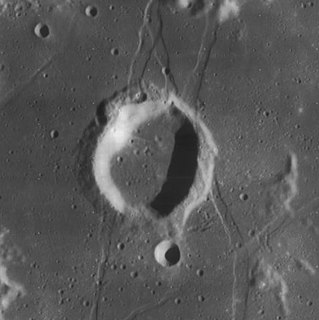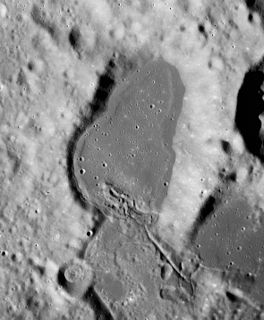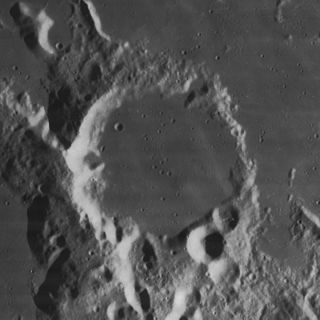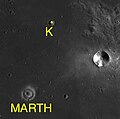
MacMillan is a bowl-shaped lunar impact crater on the eastern fringes of the Mare Imbrium. It was named after American mathematician and astronomer William Duncan MacMillan. It is located just to the southwest of a lone rise, near the southwestern edge of the Montes Archimedes. This is a cup-shaped depression in the surface with an interior albedo that matches the nearby lunar mare. The edges of the rim have a somewhat higher albedo. It shows some indications of a concentric crater.

Ramsden is a lunar impact crater located on the western stretch of the Palus Epidemiarum. It was named after British instrument maker Jesse Ramsden. To the east-southeast is the crater Capuanus, and to the north lies Dunthorne.

Humboldt is a large lunar impact crater that is located near the eastern limb of the Moon. Due to foreshortening this formation has an extremely oblong appearance. The actual shape of the crater is an irregular circle, with a significant indentation along the southeastern rim where the prominent crater Barnard intrudes. To the north-northwest of Humboldt is the large crater Hecataeus. Phillips is attached to the western rim. The rim of Humboldt is low, worn, and irregular in outline. The central peak forms a range on the crater floor. The floor surface contains a network of rilles forming a pattern of radial spokes and concentric arcs. There are also some dark patches located near the walls to the northeast, northwest, and southeast. There is a chain of craters leading from the northwest crater rim to a distance almost as long as the crater is wide. This formation is designated Catena Humboldt. Due to its location near the lunar limb, little detail was known about this crater until it was photographed by orbiting spacecraft.

Boguslawsky is a lunar impact crater that is located near the southern lunar limb. It lies to the northwest of the slightly larger crater Demonax, and southwest of the concentric crater Boussingault. Due to its location, this crater appears very oblong in shape because of foreshortening.

Descartes is a heavily worn lunar impact crater that is located in the rugged south-central highlands of the Moon. To the southwest is the crater Abulfeda. It is named after the French philosopher, mathematician and physicist René Descartes.

Doppelmayer is the remains of a lunar impact crater that lies on the southwest edge of Mare Humorum. It was named after the German mathematician and astronomer Johann Gabriel Doppelmayr. To the south-southeast is another flooded crater designated Lee, and to the southeast is Vitello. Just to the east-northeast of Doppelmayer lies the nearly submerged crater Puiseux.

Mercator is a lunar impact crater that is located on the southwestern edge of Mare Nubium, in the southwest part of the Moon. It was named after 16th-century Southern Dutch cartographer Gerardus Mercator. It is located to the southeast of the crater Campanus, and the two are separated by a narrow, winding valley.

Brianchon is a lunar impact crater that is located along the northwestern limb of the Moon. Due to its location, from the Earth the crater is seen from the edge and its visibility is somewhat affected by libration. Thus for a more detailed view, the crater must be viewed from orbit.

Bowditch is a lunar impact crater that lies on the far side of the Moon, just beyond the eastern limb. It is located on a region of the lunar surface that is brought into view due to libration, but at such times the area is viewed from the edge and so not much detail can be observed. It lies just to the north of the small Lacus Solitudinis lunar mare, between the craters Titius to the southwest and Perel'man to the east-northeast.

Brunner is a lunar impact crater that is located along the eastern limb of the Moon, to the southeast of the Mare Smythii. At this location the crater is viewed from the edge, and so it is not possible to see much detail from the Earth. The visibility of this formation is also affected by libration. The crater lies to the southwest of the walled plain Hirayama, and to the east of the elongated crater Houtermans.

Campanus is a lunar impact crater that is located on the southwestern edge of Mare Nubium. It was named after Italian astronomer Campanus of Novara. It forms a crater pair with Mercator just to the southeast. Along the southern rampart of Campanus is the small lunar mare named Palus Epidemiarum. To the southwest is the small crater Dunthorne.

Capuanus is a lunar impact crater that lies along the southern edge of the Palus Epidemiarum. It was named after Italian astronomer F. Capuano di Manfredonia. The outer rim is eroded and indented by lesser crater impacts, with notches in the north, west, and southern parts of the rim. The interior floor has been resurfaced by basaltic lava, which is connected to the surrounding lunar mare by a narrow, crater-formed gap in the northern rim. The floor is particularly notable for the hosting a number of domes, which are believed to have formed through volcanic activity.

Firmicus is a lunar impact crater that lies in the eastern part of the Moon's near side, so that from Earth it appears oval in shape due to foreshortening. It is, however, very nearly circular. The crater is located to the west of the Mare Undarum, and northeast of the similar-sized crater Apollonius. To the north of Firmicus are the craters van Albada and Auzout. Attached to its northwest rim is the Lacus Perseverantiae, a miniature lunar mare.

Damoiseau is a lunar impact crater that is located just to the west of the Oceanus Procellarum, in the western part of the Moon's near side. It lies due east of the prominent crater Grimaldi, a walled plain with a distinctive dark floor. Due south of Damoiseau is the crater Sirsalis.

Colombo is a lunar impact crater that lies on the strip of rough continental terrain between Mare Fecunditatis to the east and Mare Nectaris in the west. It is located to the south of the crater Goclenius, and northwest of Cook, and is named for the late 15th and early 16th century Italian explorer Christopher Columbus.

Crozier is a lunar impact crater that is located on the southwest edge of Mare Fecunditatis, a lunar mare in the eastern part of the Moon's near side. It lies to the east-northeast of the prominent crater Colombo, and southeast of the small crater Bellot.

Elger is a lunar impact crater that lies along the southern edge of Palus Epidemiarum, the Marsh of Epidemics, in the southwest part of the Moon's near side. To the northeast is the flooded crater Capuanus, and farther to the northwest is Ramsden.

Dalton is a lunar impact crater that is located near the western limb of the Moon's near side. It is attached to the eastern rim of the walled plain Einstein, with Balboa lying just to the north and Vasco da Gama due south. The rim of this crater is not heavily eroded, and the interior walls are terraced. The interior floor has a system of rilles that are generally concentric with the inner wall. There is a small crater near the southern inner wall, and another at the north face of the small central peak.

Chang Heng is a lunar impact crater that is located on the Moon's far side. It lies less than one crater diameter to the northeast of the walled plain Fleming. The rim of this crater is somewhat eroded, with a pair of small craters along the northern rim and tiny craters along the south and east edges. The interior floor contains a small, concentric crater that is about one third the diameter of Chang Heng. The crater is named after Chinese astronomer Zhang Heng.

Lepaute is a small lunar impact crater that is located along the western edge of the Palus Epidemiarum, a minor lunar mare in the southwestern part of the Moon's near side. It was named after French astronomer Nicole-Reine Lepaute. To the east is the larger crater Ramsden, within a system of rilles named the Rimae Ramsden. This is an elongated crater feature that is longer in the north–south direction. The outer rim is only slightly worn, and the inner walls are simple slopes that run down to the level, featureless interior floor.






















